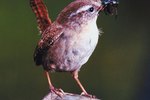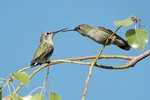
There are 75 species of swallows throughout the world, and eight are native to North America. These small, acrobatic birds feed on winged insects as they maneuver through the air. Swallows are easy to recognize in flight by their sharply pointed, angled wings and forked tails. The migratory birds mate for life and return to the same nests year after year, repairing them as needed. Swallows live an average of four years in the wild.
Bank Swallow

The bank swallow has a brown back and white belly. It nests in steep, vertical cliffs and banks along rivers, streams, ocean coasts or reservoirs where it can hunt for insects that swarm over the water. The bank swallow tunnels into soft, sandy cliffs and construct its nest of plant materials inside the hole. Bank swallows live in colonies that range from 10 to 2,000 breeding pairs.
Barn Swallow

Barn swallows have deep orange-colored throats, buff undersides and blue-black backs. They build cup-shaped nests of mud in barn rafters or on building walls, under roofs or bridges and in caves. Barn swallows often fly very low over the ground or water in search of insects.
Cave Swallow

Cave swallows are light brownish birds with reddish cheeks and lighter undersides. They nest on vertical walls inside the entrances of sinkholes, buildings, bridges, culverts and caves, where they often share space with bats. Their nests are shaped like flattened cups made of mud pellets and lined with grass and plant fibers. Sometimes, the sides extend up and enclose the nest with a small entrance tunnel on one side.
Cliff Swallow

The cliff swallow has a blue-black back with a white forehead and reddish throat. It nests in large colonies on the walls of buildings, cliffs and under bridges that are near open foraging areas where they can hunt insects in the air. They build gourd-shaped nests out of mud, and some swallows will lay eggs in other swallows' nests. Occasionally a female swallow will even carry one of her own eggs in her beak and put it in another nest. If a cliff swallow has had a hard time locating food, it will watch other swallows in the colony and follow them to insect swarms.
Northern Rough-Winged Swallow

The northern rough-winged swallow is a plain brown bird that gets its name from its outer wing feathers that have small barbed feathers on their leading edges. The swallow's Greek genus name, Stelgidopteryx, means "scraper wing," and the Latin species name, serripennis, means "saw feather." This swallow nests on vertical surfaces within the openings of banks, gorges and human-built structures.
Purple Martin

Purple martins are the largest swallows. Males are glossy indigo and females are brown. In natural situations, they nest in woodpecker holes in dead trees along forest edges and rivers, but near human habitations they will roost in man-made martin houses. In late summer, as soon as the chicks leave the nest, martins will gather by the thousands, creating such dense flocks that they can be detected by weather radar.
Tree Swallow

The tree swallow has a white underside, and its back is a dark, shiny blue-green. It lives in sparse woodlands, usually near water where it can easily catch swarming insects. Tree swallows nest in tree cavities, buildings and birdhouses. They use feathers from other birds to line their nests to help keep nestlings warm and deter parasitic mites. Because the tree swallow winters farther north than any other American swallow, it will eat plant material when cold weather makes insects scarce.
Violet-Green Swallow

The violet-green swallow closely resembles the tree swallow, with light underparts and a dark, shiny, purple-green back. It breeds in open woodlands, especially at middle elevations. Its nest is a shallow cup of grass and small twigs lined with feathers that's located within a hole in a tree, cliff cavity or nest box.
References
Photo Credits
-
David De Lossy/Photodisc/Getty Images
Writer Bio
Jennifer Bové is an award-winning contributor to "Your Big Backyard" magazine. She also writes for the National Wildlife Federation website and other online publications. Bové has published three books of nature-related stories, and she holds a B.S. in biology from the University of Missouri.



